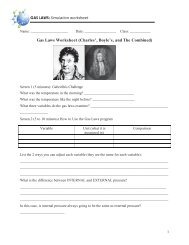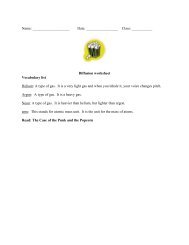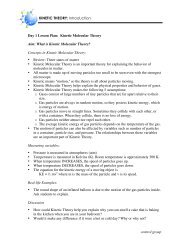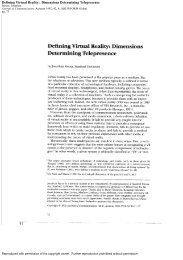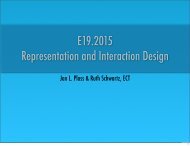Evaluating and managing cognitive load in educational games
Evaluating and managing cognitive load in educational games
Evaluating and managing cognitive load in educational games
You also want an ePaper? Increase the reach of your titles
YUMPU automatically turns print PDFs into web optimized ePapers that Google loves.
<strong>Evaluat<strong>in</strong>g</strong> <strong>and</strong> Manag<strong>in</strong>g Cognitive Load <strong>in</strong> Games<br />
Breuer (2002) consists of two ma<strong>in</strong> components:<br />
a curriculum (macro-) component that ma<strong>in</strong>ta<strong>in</strong>s<br />
a student model <strong>and</strong> an external knowledge base,<br />
<strong>and</strong> an <strong>in</strong>structional (micro-) component that adapts<br />
the <strong>in</strong>structional strategies accord<strong>in</strong>g to current<br />
learn<strong>in</strong>g progress.<br />
An adaptive approach that has been developed<br />
with<strong>in</strong> the <strong>cognitive</strong> <strong>load</strong> framework is based on<br />
the expertise reversal effect (Camp, Paas, Rikers, &<br />
van Merriënboer, 2001; Kalyuga, 2006c; Kalyuga<br />
& Sweller, 2004, 2005; Salden, Paas, Broers, &<br />
van Merriënboer, 2004; Salden, Paas, & van Merriënboer,<br />
2006; van Merriënboer & Sweller, 2005)<br />
<strong>and</strong> assumes the <strong>in</strong>itial selection of an optimal level<br />
of learner support based on pre-task measures,<br />
<strong>and</strong> then ref<strong>in</strong><strong>in</strong>g <strong>and</strong> optimiz<strong>in</strong>g <strong>in</strong>structional<br />
procedures us<strong>in</strong>g cont<strong>in</strong>uous monitor<strong>in</strong>g of learn<strong>in</strong>g<br />
behavior. Accord<strong>in</strong>g to <strong>cognitive</strong> <strong>load</strong> theory,<br />
optimiz<strong>in</strong>g learn<strong>in</strong>g processes requires present<strong>in</strong>g<br />
appropriate <strong>and</strong> necessary <strong>in</strong>structional guidance<br />
at the right time <strong>and</strong> cont<strong>in</strong>uously remov<strong>in</strong>g unnecessary<br />
redundant <strong>in</strong>formation as the level of<br />
learner expertise <strong>in</strong> a doma<strong>in</strong> gradually <strong>in</strong>creases.<br />
Detailed direct <strong>in</strong>structional support should be<br />
provided (preferably <strong>in</strong> <strong>in</strong>tegrated verbal-pictorial<br />
<strong>and</strong> dual-modality formats) for novice learners.<br />
Changes <strong>in</strong> the task-specific knowledge base need<br />
to be dynamically tracked <strong>and</strong> specific <strong>in</strong>structional<br />
procedures tailored accord<strong>in</strong>gly.<br />
The described adaptive approach has mostly<br />
been realized <strong>in</strong> experimental computer-based<br />
tutorials <strong>in</strong> a system-controlled format: a computer<br />
program dynamically selects an <strong>in</strong>structional<br />
method that is most appropriate for the current<br />
level of learner expertise. The learner-controlled<br />
approach could be an alternative to dynamic system-controlled<br />
tailor<strong>in</strong>g of <strong>in</strong>struction to learner<br />
characteristics. Despite some expected advantages<br />
of learner control (e.g., positive learner attitudes<br />
<strong>and</strong> a sense of control), research f<strong>in</strong>d<strong>in</strong>gs have<br />
been more often negative rather than positive <strong>in</strong><br />
relation to learn<strong>in</strong>g outcomes (Niemec, Sikorski,<br />
& Walberg, 1996; Ste<strong>in</strong>berg, 1989). Accord<strong>in</strong>g to<br />
<strong>cognitive</strong> <strong>load</strong> theory, the level of learner expertise<br />
is a def<strong>in</strong><strong>in</strong>g factor: students could have control<br />
over the content <strong>and</strong> <strong>in</strong>structional sequences if<br />
they have sufficient knowledge <strong>in</strong> the task doma<strong>in</strong>.<br />
Low-knowledge learners, on the other h<strong>and</strong>, require<br />
appropriate assistance. This assistance could be<br />
provided as advice to learners to make their own<br />
decisions (Tennyson, 1981). An advanced form of<br />
this approach is an adaptive guidance strategy that<br />
provides learners with <strong>in</strong>formation on the current<br />
level of their knowledge, what to study or practice<br />
to achieve mastery, how to sequence learn<strong>in</strong>g tasks<br />
for gradual transition from basic to more complex<br />
strategies, <strong>and</strong> how to allocate <strong>cognitive</strong> resources<br />
(Bell & Kozlowski, 2002).<br />
The available research on <strong>cognitive</strong>ly optimized<br />
adaptive strategies with<strong>in</strong> a <strong>cognitive</strong> <strong>load</strong> framework<br />
is very limited. Optimal adaptive methodologies<br />
<strong>and</strong> conditions of their applicability need to<br />
be established <strong>in</strong> controlled experimental studies.<br />
In the absence of evidence-based recommendations,<br />
most exist<strong>in</strong>g adaptive onl<strong>in</strong>e environments<br />
are based on monitor<strong>in</strong>g navigational patterns,<br />
learn<strong>in</strong>g styles, preferences, <strong>and</strong> other external<br />
learner characteristics rather than deep <strong>cognitive</strong><br />
characteristics, such as available knowledge<br />
structures.<br />
cONcLUsION AND IMPLIcAtIONs<br />
This chapter makes a first contribution to apply<br />
<strong>cognitive</strong> <strong>load</strong> theory to the design of <strong>educational</strong><br />
game environments. Research <strong>in</strong> cognition <strong>and</strong><br />
<strong>in</strong>struction has substantially exp<strong>and</strong>ed our underst<strong>and</strong><strong>in</strong>g<br />
of mental processes <strong>in</strong>volved <strong>in</strong> learn<strong>in</strong>g,<br />
limitations of our <strong>cognitive</strong> system, <strong>and</strong> the role of<br />
learner prior knowledge. Apply<strong>in</strong>g this knowledge<br />
to the design of <strong>educational</strong> <strong>games</strong> is a necessary<br />
condition for their effectiveness.<br />
Games have unique features that place higher<br />
dem<strong>and</strong>s on learners’ <strong>cognitive</strong> resources than<br />
more traditional direct <strong>in</strong>struction approaches.<br />
Examples for sources of these dem<strong>and</strong>s are the<br />
need to navigate immersive 3D environments, the<br />
732



